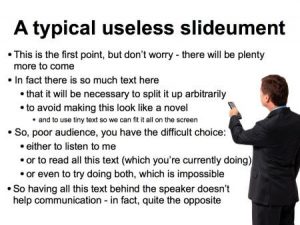Lists of facts do not make a good presentation.
Sense is made by structure in an argument.
Lists of facts impose a structure and hierarchy.
Indenting text makes it sub-ordinate to the preceding text.
The majority of text on a screen cannot be read by the majority of the audience
Lists of facts do not aid understanding.
Textual repetition of a spoken list does not add to understanding.
Sub-ordinate text is of lesser importance and will be skipped over by a reader.
Fact after fact after fact is not a presentation.
Data requires context and meaning for understanding.
The facts individually are valid.
There is clear evidence that text on a screen inhibits learning.
Cognitive load is a psychological concept.
Here is a cartoon to break things up.
Reading, listening, writing and thinking cannot be carried out together.
If more than one process is attempted, the cognitive overload will be such that one process is inhibited.
More than seven lines on a slide mean that only the first five will be read completely.
If a subsequent concept is introduced before the prior concept is understood, there will be lack of processing.
Data is not understanding.
Lack of flow limits understanding.
Bulletpoints limit and constrain presenters.
Reading out text is not the same as teaching.

A presentation must have meaning. Meaning is gained from facts knitted together with structure and delivered with flow. Lists cannot achieve this. A great presentation, whether scientific or otherwise, is not made using lists.